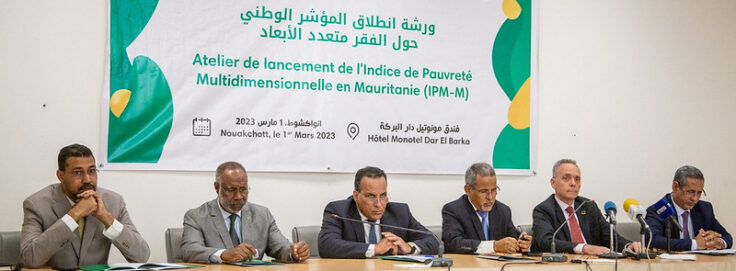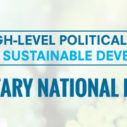
Search
Mauritania launches Multidimensional Poverty Index

Mauritania’s Multidimensional Poverty Index (Indice de Pauvreté Multidimensionnelle de la Mauritanie, IPM-M) is a complementary measure of poverty, to reflect the multiple deprivations of the population in terms of education, health, living conditions and employment
Mauritania has recently launched a Multidimensional Poverty Index (Indice de Pauvreté Multidimensionnelle de la Mauritanie, IPM-M) to track the country’s progress in eradicating poverty. The IPM-M, launched on 1 March, offers a more comprehensive understanding of poverty beyond income and examines the range of deprivations that people face in health, education, employment and living standards.
According to the IPM-M, in Mauritania, 2.3 million people, or 56.9% of the population live in multidimensional poverty. These people are deprived on average in 56.3% of the weighted indicators in education, health, living standards and employment. Children aged 0 to 17, who represent more than half (50.7%) of the Mauritanian population, constitute the poorest age group: 61.9% of them live in multidimensional poverty and the value of their IPM-M is 0.352, the highest among all age groups. About 1.3 million poor people in Mauritania are children, which corresponds to more than half of the country’s poor population. Rural areas are pockets of poverty that require government attention, as nearly eight out of ten people (77.1 per cent) live in multidimensional poverty. Real disparities are noted in the level of multidimensional poverty measured by the IPM-M between the Wilayas, which varies from 0.122 in Tirs Zemmour (the least poor Wilaya) to 0.577 in Guidimagha (the poorest Wilaya).
The IPM-M was developed through a partnership between ANSADE (Agence Nationale de la Statistique, de l’Anlayse Démographique et Économique – National Statistics Office), UNICEF and OPHI. The IPM-M construction process was led by an inclusive multisectoral steering committee comprising key national Ministries and Agencies in charge of poverty reduction and the promotion of sustainable development in Mauritania, as well as ANSADE and UNICEF.
The work of the steering committee made it possible to contextualize the choice of the IPM-M dimensions and indicators that characterize poverty in Mauritania, using data from the Permanent Survey of Living Conditions of Households (EPCV, 2019). A total of 19 indicators grouped into 4 dimensions were selected for the calculation of the IPM-M in line with the country’s forward-looking vision of development, national and sectoral strategies and commitments defined through international agendas (SDG 2015, AU Agenda 2063).
The IPM-M provides a more complete picture of poverty in Mauritania. It identifies the places and population groups that are most affected by poverty, as well as the contribution of different dimensions to the vulnerability of populations, in order to provide strategic guidance to leave no one behind and thus reduce poverty and inequality in the country. Thus, the IPM-M does not replace the measure of income poverty but complements it to better target public actions to eradicate poverty in all its forms. Multidimensional poverty measurement is essential to better guide strategies, policies and programmes that address different aspects of poverty and to improve the targeting of the most vulnerable populations.
At the launch, the Secretary General of the Ministry of Economic Affairs and Promotion of the Productive Sector (MAEPSP), said that: ‘The fight against poverty, inequality and discrimination is a priority in our economic and social policies. The National Strategy for Accelerated Growth and Shared Prosperity (SCAPP-2016–2030) and the Expanded Priority Program of the President of the Republic (ProPEP), in line with the targets of the Sustainable Development Goals (SDG 2015–2030), aim to “completely eradicate extreme poverty in the country and reduce by half, at least, the proportion of men, women and children of all ages living in poverty in all its dimensions, by 2030’.
The IPM-M will be updated every four years as part of the conduct of the Permanent Survey of Living Conditions of Households (EPCV) to monitor progress in poverty reduction and to provide guidance on the effectiveness of government policies and programs.
The development of the IPM-M is an important contribution to the establishment of a monitoring tool for the SCAPP (SCAPP-2016–2030) and the global goals (SDGs 2015–2030) and particularly target 1.2 and indicator 1.2.2 which aims to “reduce by at least half the proportion of men, women and children of all ages living in poverty in all its forms, as defined by each country, by 2030”.
More info:
ANSADE, UNICEF & OPHI (2022). Pauvreté Multidimensionnelle en Mauritanie. ANSADE, Nouakchott. (French)
(Factsheet) ANSADE, UNICEF & OPHI (2022). Indice de Pauvreté Multidimensionnelle en Mauritanie. (French)
ESCWA (2024). Note d’orientation sur l’optimisation des politiques et investissements pour la réduction de la pauvreté en Mauritanie (French)
Watch the recording of the launch of Mauritania MPI 2022 on 1st March 2023 and experts debate.
Photos from the launch of Mauritania MPI 2022 on 1st March 2023
Download the Mauritania MPI 2022 Press Release (in French)
Download the Mauritania MPI 2022 Press Release (in Arabic)
Download the Mauritania MPI 2022 Policy Brief (in French)
Download the Mauritania MPI 2022 Factsheet (in French)
















